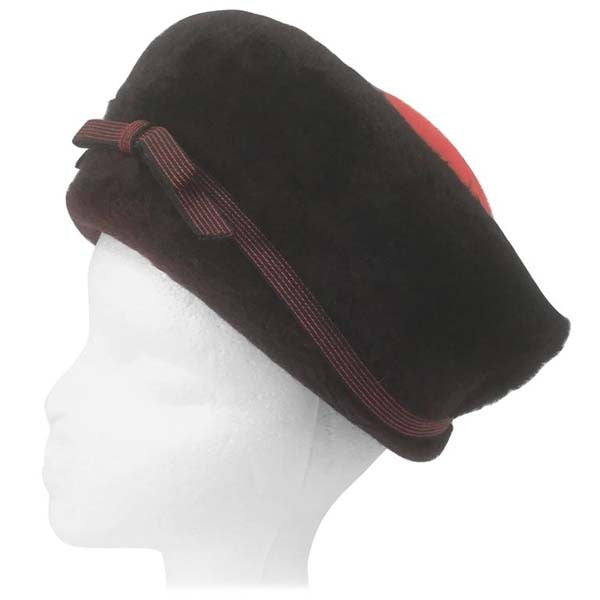1970s Miss Carnegie by Hattie Carnegie Notch Back Bow Hat
$305.00
Description
This fantastic bohemian felt hat by Miss Carnegie by Hattie Carnegie has a rounded crown and a distinctive folded notch at the back of the wide brim. The hat features a polkadot pattern throughout, a thin grosgrain ribbon at the base of the crown, and two fan-like ribbon arrangements, one in each of the notch folds. The hat - with its wide brim, 70s ochre-black color scheme, and bonnet construction- is both funky and fantastic!
Modern US Size: Medium Circumference: 23, Diameter: 9 inches
*All garments and accessories have been professionally cleaned and thoroughly checked before shipping. They are ready to wear upon arrival.
*Shipping includes signature required and insured full value
Hattie Carnegie was born Henrietta Kanengeiser in Vienna, Austria-Hungary. She was the second of seven children, and lived in poverty in her youth. The family immigrated to the United States when she was still a child, and settled in Manhattan. After her father’s death in 1902, Hattie took a job as a messenger at Macy’s to help support her family, and in 1904 she modeled and trimmed hats at a millinery.
In 1909 Hattie branched out, launching a hat making business with dressmaker Rose Roth, but by 1919 Roth had left the business, leaving Carnegie as the owner of “Hattie Carnegie, Inc,” a company that had a working capital of $100,000. Carnegie began traveling to Paris to buy original dresses to both sell in her shop, and use as inspiration for her own garment and accessory designs. Carnegie was instrumental in bringing Paris fashion to the United States; she imported Lanvin, Molyneux, Patou, Schiaparelli, Vionnet, and others, lavishing New York with gorgeous garments and groundbreaking designers that would have not crossed the pond otherwise. Carnegie also discovered and nurtured the talents of many prominent American designers, including Norman Norell, Pauline Trigère, and James Galanos. In 1925, Carnegie bought a building off of Park Avenue to house her $3.5-million-a-year business, and stayed there producing pieces throughout the Great Depression.
During World War II French haute couture came to a standstill. Carnegie rose to prominence on the international stage as an authority on fashion, and her works were seen in the theatre, cinema and on magazine covers. Although still glamorous, her designs became more austere when the United States joined the Allied Powers. As a part of the war effort, Carnegie designed a dress for Life Magazine. The dress patterns were published in the magazine alongside detailed instructions; it was said that although the dress could have been made for as little as $5, the original dress was valued at $175. After the war, Carnegie continued her business, the epitome of perseverance.
Sometime in her early 20s, Hattie had taken the last name Carnegie after Andrew Carnegie, the industrialist, philanthropist, and richest man in the United States during her lifetime. She certainly lived up to the name, having worked her way through and out of an impoverished childhood and into a glamorous life doing what she loved, while still grossing millions a year. Carnegie passed away in 1956, having been instrumental in the diffusion of Parisian fashion into American society, having nurtured the finest designing minds of the early and mid 20th century, and having designed all manner of enchanting things, including hats, handbags, gloves, jewelry, furs, lingerie, cosmetics, and even perfume.
-
Materials & Techniques
-
Size
Related Items
1950s Balenciaga Reproduction Peach Basket Hat in Subtle Green
$180.00
Striking and flirty comes this adorable green woven hat by Balenciaga! This bonnet - like hat is composed of ovarlapping white and green loops, and features a low, round crown, and a brim that curves downwards towards the wearer's face. The structure of the hat tapers towards the back, ending in a narrow brim with thin, elegant accent bow.
In the 1950s, before European designers began exporting their pieces en masse to the United States, they would license their designs to American companies. These American companies would then fabricate the items and sell them to clients stateside. Although this cap is not directly from their atelier in Europe, the design is authentically Balenciaga!
1950s Custom Neiman Marcus Sienna Snakeskin Turban
$550.00
Absolutely gorgeous mid century sienna brown snakeskin turban custom made by the Neiman Marcus department store. The turban is made of ruched snakeskin and gathers in a bow at the back. The piece is rather versatile and can be worn backwards with the bow in front, or sideways for flair! The snakeskin is supple but well molded and retains its shape. The cap is lined in silk organza.
Wonderful wearable Gift! Great also for fashion shoots, runway shows, and screen or stage!
20.5"
1950s Elsa Schiaparelli Red and Black Felt Eastern Hat
$295.00
Striking red and black felt hat by Elsa Schiaparelli! This structured hat has aristocratic eastern influences, resembling a cossack hat, a Manchurian hat, and a Qing dynasty winter court official hat! The hat has a black upturned brim that rises above the red crown in the front, and tapers to a narrow brim in the back; the interior of the brim is red. The brim features a delicate, thin, black, grosgrain ribbon with horizontal red stitching. The ribbon wraps around the hat entirely, appearing to originate from in between a notch in the brim at the back of the hat, and ending in a long, flat bow at the front. The body of the hat was made in Italy.
Modern US Size: S Circumference: 20 1/2, Diameter: 7 inches
*All MRS Couture garments and accessories have been professionally cleaned and thoroughly checked before shipping. They are ready to wear upon arrival.



